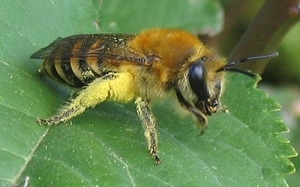Ivy bee
 Just as it feels like the summer season is winding down for the cooler months and plants are dying back, one species is just waking up and raring to go, as its food plant comes into bloom providing an abundant source of pollen – the ivy bee (Colletes hederae).
Just as it feels like the summer season is winding down for the cooler months and plants are dying back, one species is just waking up and raring to go, as its food plant comes into bloom providing an abundant source of pollen – the ivy bee (Colletes hederae).
I have received several calls about the ivy bee in the last few weeks so I thought it would be just the right species to focus on this month, as so many people are noticing this unknown species in their gardens and fields.
So, what does this ivy bee look like? Size-wise, they are medium to large – 1.0 to 1.3cm in length, just bigger than a honeybee – but look slightly different to a honeybee and can be identified by the cream orange/yellow bands on their abdomens, ginger fur on the thorax, and heart-shaped face.
The ivy bee is a relatively new species to the British Isles, arriving in Britain from mainland Europe in 2001, and has since spread rapidly from the southern coast of England to south Wales, and has been recorded in the coastal regions of Northumberland in 2019 and as far inland as the North Pennines. But you can only see this bee for a short amount of time in the year, as this species has a single flight period from early September to the start of November.
The ivy bee belongs to a group of solitary bees known as ‘plasterer bees’. Females secrete cellophane-like material to line and waterproof their nests, and as the name suggests, ivy is an essential food source, both for nectar and pollen, but other late season flowers such as ragwort may be used for nectar. Common in urban and farmland settings, as well as heathland and coastal areas, the females nest alone, digging their burrows measuring up to almost half a metre in depth, in loose, light, or sandy soil in areas of bare ground and short lawns with ivy growing nearby for foraging. When conditions are suitable, there may be thousands of nests in the same area.
If you are lucky enough to find nest burrows of the ivy bee, look out for males taking their opportunity to mate with emerging females, to father the next generation in mid-September. It can be quite a spectacle with fierce competition with many males attempting to mate with the same female and becoming entangled in what is called a “mating ball”. With so many males in one place, the effect of this frenzied activity can be quite extraordinary!
But don’t be concerned if you discover these bees nesting in your lawn in large numbers. They are not aggressive, and they will probably only be around for about six weeks and then the excitement will be over.
Megan Lock
Advisory
Photo credit: Wofl